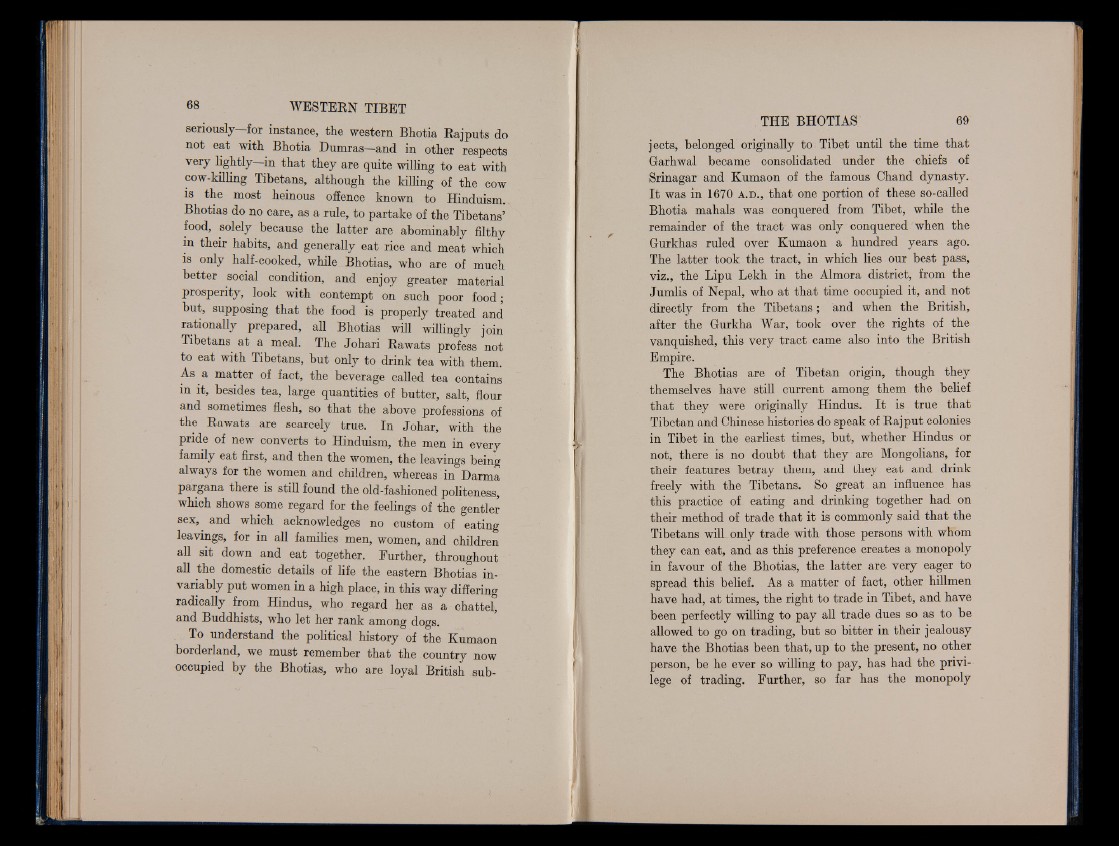
seriously—for instance, the western Bhotia Rajputs do
not eat with Bhotia Dumras—and in other respects
very lightly in that they are quite willing to eat with
cow-killing Tibetans, although the killing of the cow
is the most heinous offence known to Hinduism.
Bhotias do no care, as a rule, to partake of the Tibetans’
food, solely because the latter are abominably filthy
m their habits, and generally eat rice and meat which
is only half-cooked, while Bhotias, who are of much
better social condition, and enjoy greater material
prosperity, look with contempt on such poor food;
but, supposing that the food is properly treated and
rationally prepared, all Bhotias will willingly join
Tibetans at a meal. The Johari Rawats profess not
to eat with Tibetans, but only to drink tea with them.
As a matter of fact, the beverage called tea contains
in it, besides tea, large quantities of butter, salt, flour
and sometimes flesh, so that the above professions of
the Rawats are scarcely true. In Johar, with the
pride of new converts to Hinduism, the men in every
family eat first, and then the women, the leavings being
always for the women and children, whereas in Darma
pargana there is stiff found the old-fashioned politeness,
which shows some regard for the feelings of the gentler
sex, and which acknowledges no custom of eating
leavings, for in all families men, women, and children
all sit down and eat together. Further, throughout
all the domestic details of life the eastern Bhotias invariably
put women in a high place, in this way differing
radically from Hindus, who regard her as a chattel,
and Buddhists, who let her rank among dogs.
To understand the political history of the Kumaon
borderland, we must remember that the country now
occupied by the Bhotias, who are loyal British subjects,
belonged originally to Tibet until the time that
Garhwal became consolidated under the chiefs of
Srinagar and Kumaon of the famous Chand dynasty.
It was in 1670 A.D., that one portion of these so-called
Bhotia mahals was conquered from Tibet, while the
remainder of the tract was only conquered when the
Gurkhas ruled over Kumaon a hundred years ago.
The latter took the tract, in which lies our best pass,
viz., the Lipu Lekh in the Almora district, from the
Jumlis of Nepal, who at that time occupied it, and not
directly from the Tibetans; and when the British,
after the Gurkha War, took over the rights of the
vanquished, this very tract came also into the British
Empire.
The Bhotias are of Tibetan origin, though they
themselves have still current among them the belief
that they were originally Hindus. It is true that
Tibetan and Chinese histories do speak of Rajput colonies
in Tibet in the earliest times, but, whether Hindus or
not, there is no doubt that they are Mongolians, for
their features betray them, and they eat and drink
freely with the Tibetans. So great an influence has
this practice of eating and drinking together had on
their method of trade that it is commonly said that the
Tibetans will only trade with those persons with whom
they can eat, and as this preference creates a monopoly
in favour of the Bhotias, the latter are very eager to
spread this belief. As a matter of fact, other hillmen
have had, at times, the right to trade in Tibet, and have
been perfectly willing to pay all trade dues so as to be
allowed to go on trading, but so bitter in their jealousy
have the Bhotias been that, up to the present, no other
person, be he ever so willing to pay, has had the privilege
of trading. Further, so far has the monopoly